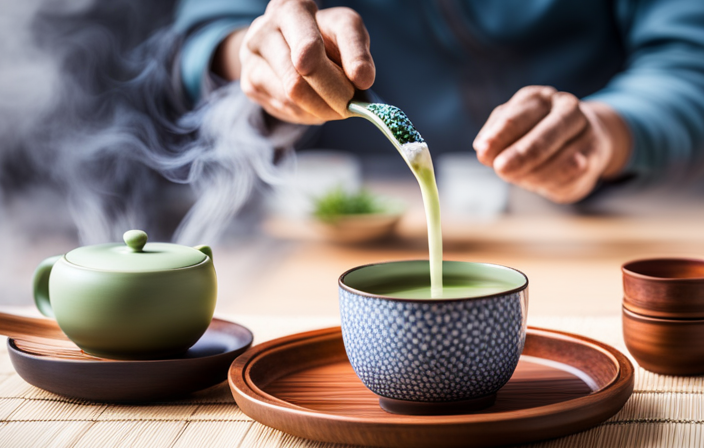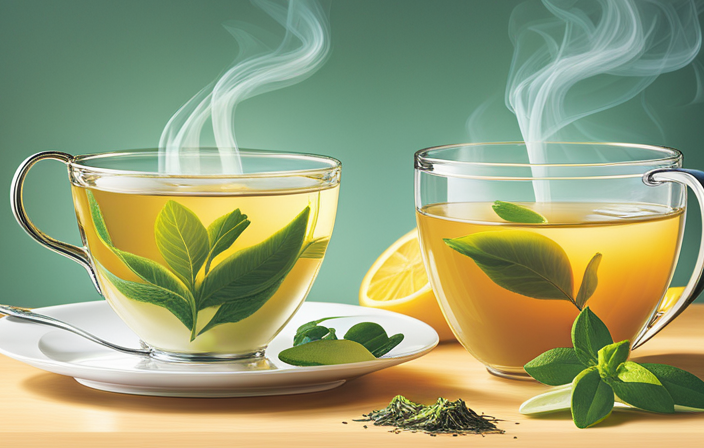Rooibos Tea
What Is The Difference Between Rooibos And Green Tea

As a tea enthusiast, I am always on the lookout for new and interesting brews to tantalize my taste buds. Today, I want to delve into the world of two popular teas: rooibos and green tea. These two teas may seem similar at first glance, but upon closer inspection, their differences become apparent.
From origins and cultivation methods to flavor profiles and health benefits, there is much to explore. Join me on this journey as we unravel the mysteries of rooibos and green tea. Prepare to be amazed by the unique alliteration of earthy rooibos and grassy green tea, as we sip our way through the intricacies of these delightful brews.
So grab your favorite mug, settle in, and let’s embark on an adventure of taste and discovery.
Key Takeaways
- Rooibos tea and green tea have distinct flavors and brewing methods.
- Rooibos tea is caffeine-free and can be enjoyed hot or cold, making it suitable for a calming evening.
- Green tea provides a refreshing pick-me-up during the day and is enjoyed alongside light meals and social gatherings.
- Rooibos tea has cultural significance in South Africa, while green tea is culturally significant in countries like Japan.
Origins and Cultivation Methods
Rooibos, also known as red tea, originates from the rugged Cederberg region of South Africa, while green tea has its origins deeply rooted in ancient Chinese traditions. The cultivation techniques for these two teas differ significantly.
Rooibos plants thrive in the sandy soil and Mediterranean-like climate of South Africa, where they are cultivated using sustainable farming methods. The historical significance of rooibos lies in its long-standing use by the indigenous Khoisan people, who recognized its medicinal properties.
Green tea, on the other hand, is cultivated in China using meticulous methods that have been refined over thousands of years. The tea leaves are carefully picked, withered, and then pan-fired or steamed to prevent oxidation. This ancient processing technique gives green tea its distinctive flavor.
Moving on to the subsequent section about processing techniques, let’s explore how these teas are transformed into the final products.
Processing Techniques
When it comes to processing techniques, there are distinct differences between rooibos and green tea.
Rooibos undergoes a fermentation and drying process, resulting in a reddish-brown color and a sweet, earthy flavor.
On the other hand, green tea is steamed or pan-fried to prevent oxidation, which allows it to retain its vibrant green color and impart a refreshing, grassy taste.
These unique processing methods contribute to the distinct characteristics and flavors of each tea.
Rooibos – Fermented and dried, resulting in a reddish-brown color and sweet, earthy flavor
If you’re looking for a unique and flavorful tea, you’ll love the rich, reddish-brown hue and sweet, earthy taste of fermented and dried rooibos. Rooibos undergoes a fermentation process, where the leaves are bruised and then left to oxidize, resulting in its distinct color and flavor. This fermentation process not only gives rooibos its characteristic taste, but also enhances its medicinal properties.
Here are some key points to know about fermented rooibos:
- The fermentation process involves bruising the leaves to initiate oxidation.
- Fermented rooibos has a reddish-brown color and a sweet, earthy flavor.
- It is rich in antioxidants, which can help boost the immune system and promote overall health.
- Rooibos is naturally caffeine-free, making it a great choice for those looking to reduce caffeine intake.
- Its soothing properties make it a popular choice for relieving digestive issues.
Now, let’s move on to green tea, which is steamed or pan-fried to prevent oxidation, retaining its green color and grassy taste.
Green Tea – Steamed or pan-fried to prevent oxidation, retaining its green color and grassy taste
Experience the vibrant green color and refreshing grassy taste of green tea, a delightful beverage that’s steamed or pan-fried to preserve its natural goodness.
Unlike rooibos, green tea undergoes minimal oxidation, thanks to its unique processing methods. The leaves are carefully steamed or pan-fried, which helps retain their vibrant green color and distinct grassy flavor. Steaming is a common method used in Japan, while pan-frying is more prevalent in China. This variation in processing techniques contributes to the subtle differences in taste between the two teas.
While rooibos boasts a sweet and earthy flavor, green tea offers a refreshing and grassy taste that’s truly invigorating.
Transitioning into the next section, let’s now explore the caffeine content of these two remarkable teas.
Caffeine Content
Although both rooibos and green tea contain caffeine, green tea generally has a higher caffeine content than rooibos. This means that if you’re particularly sensitive to caffeine or trying to limit your intake, rooibos might be a better choice for you. Green tea’s higher caffeine content can provide a boost of energy and improve mental alertness, but it can also cause restlessness or sleep disturbances in some individuals. If you prefer the taste and health benefits of green tea but want to reduce your caffeine intake, there are decaffeinated options available.
Now, let’s transition into discussing the flavor profiles of rooibos and green tea.
Flavor Profiles
Get ready to taste the unique flavor profiles of these two popular herbal beverages – rooibos and green tea! Both rooibos and green tea offer distinct flavors that cater to different flavor preferences.
Rooibos has a naturally sweet and nutty taste with hints of caramel and vanilla. It is known for its smooth and mellow flavor, making it a favorite among those who prefer a sweeter and less bitter taste.
On the other hand, green tea has a more grassy and vegetal flavor, with a slight hint of bitterness. It is often described as refreshing and light.
When choosing between rooibos and green tea, it’s important to consider not only your flavor preferences but also any health concerns you may have.
Now, let’s explore the health benefits of these two herbal beverages.
Health Benefits
Let’s delve into the amazing health benefits that both rooibos and green tea have to offer! Both teas are packed with antioxidants, but they also have unique properties that set them apart. Green tea is known for its weight loss benefits, as it boosts metabolism and aids in fat burning. It contains catechins, a type of antioxidant that promotes weight loss. On the other hand, rooibos tea is caffeine-free and contains aspalathin, a flavonoid that helps reduce stress hormones and prevent the formation of new fat cells. To showcase the health benefits of both teas, let’s take a look at the table below:
| Health Benefits | Rooibos Tea | Green Tea |
|---|---|---|
| Weight Loss | Promotes weight loss by reducing stress hormones and preventing new fat cell formation | Boosts metabolism and aids in fat burning with its catechins content |
| Antioxidant Properties | High levels of antioxidants help fight free radicals and reduce inflammation | Rich in polyphenols, which protect against heart disease and support overall health |
Now that we understand the health benefits of rooibos and green tea, let’s explore their brewing methods and discover the best ways to enjoy these wonderful beverages.
Brewing Methods
One key aspect to consider when preparing both rooibos and green tea is the brewing method, as it can greatly impact the taste and overall experience of enjoying these beverages. While traditional brewing methods for both teas involve steeping them in hot water, there are alternative brewing methods that can enhance their flavors and health benefits.
For rooibos tea, cold brewing is becoming increasingly popular, as it results in a smoother and less bitter taste. On the other hand, green tea can be brewed using the traditional method but with variations in water temperature and steeping time, allowing for different flavor profiles to emerge.
When comparing the health benefits of the two teas, brewing method can also play a role as it affects the extraction of antioxidants and other beneficial compounds.
Transitioning into the subsequent section about ‘varieties and blends’, it is important to understand how brewing methods can influence the characteristics of different rooibos and green tea varieties.
Varieties and Blends
When it comes to varieties and blends, rooibos tea is available in a multitude of flavors, allowing for a diverse and enjoyable tea-drinking experience. Some popular options include vanilla, citrus, and berry blends, each offering a unique twist to the naturally sweet and earthy taste of rooibos.
On the other hand, green tea presents a wide range of types to choose from, such as sencha, matcha, and jasmine green tea. These variations provide distinct flavor profiles and brewing methods, allowing tea enthusiasts to explore and appreciate the nuances of green tea.
Rooibos – Available in various flavors, including vanilla, citrus, and berry blends
With a variety of flavors such as vanilla, citrus, and berry blends, rooibos tea offers a delightful twist to your usual green tea routine. Not only does it provide numerous health benefits, but it also caters to different taste preferences. To give you a better idea of the options available, here is a table showcasing some of the popular rooibos flavors:
| Flavor | Description | Best Brewing Method |
|---|---|---|
| Vanilla | Smooth and creamy with a hint of sweetness | Steep for 5 minutes |
| Citrus | Refreshing and zesty | Steep for 4 minutes |
| Berry Blends | Fruity and vibrant | Steep for 3 minutes |
Each flavor can be enjoyed hot or cold, making rooibos tea a versatile choice for any occasion. Now, let’s explore the wide range of green tea types, such as sencha, matcha, and jasmine green tea, which offer their own unique flavors and brewing methods.
Green Tea – Offers a wide range of types, such as sencha, matcha, and jasmine green tea
Explore the captivating world of green tea, where a diverse array of types like sencha, matcha, and jasmine await to enchant your taste buds and invigorate your senses.
Sencha, a popular variety of green tea, is known for its grassy, refreshing flavor. It undergoes a steaming process that preserves its vibrant green color and delicate taste.
Matcha, on the other hand, is a finely ground powdered green tea that’s rich in umami flavor and provides a concentrated dose of antioxidants. It’s traditionally whisked into hot water, creating a frothy and indulgent beverage.
Another enticing option is jasmine green tea, which offers the delightful aroma of jasmine flowers infused into the tea leaves. It not only provides a fragrant experience but also has numerous health benefits, including improved digestion and reduced stress levels.
Transitioning into the next section, the suitability of these green teas for different occasions is worth exploring.
Suitability for Different Occasions
For a calming and relaxing evening, nothing beats sipping on a warm cup of rooibos or green tea. While both options offer a soothing experience, they are suited for different occasions.
Rooibos tea, with its naturally caffeine-free nature and earthy flavor, is perfect for unwinding before bedtime. Its gentle taste pairs well with desserts like chocolate or vanilla-based treats. Additionally, rooibos tea holds cultural significance in South Africa, where it is indigenous.
Green tea, on the other hand, provides a refreshing pick-me-up during the day. Its diverse range of types, such as sencha, matcha, and jasmine green tea, offers different flavor profiles and aromas. Green tea is often enjoyed alongside light meals or as a refreshing beverage during social gatherings. Its cultural significance can be found in countries like Japan, where tea ceremonies are a celebrated tradition.
Frequently Asked Questions
How long does it take for rooibos and green tea to grow and be harvested?
The growth period for rooibos is approximately 18 months, while the harvesting time for green tea varies depending on the specific type, but it is generally harvested within the first few weeks after the leaves have sprouted.
Are there any specific environmental conditions required for growing rooibos and green tea?
Specific environmental conditions are required for the growth and harvest of rooibos and green tea. Factors like temperature, rainfall, and soil quality play a crucial role in ensuring optimal growth and a successful harvest.
Can rooibos and green tea be mixed together to create a unique blend?
Yes, rooibos and green tea can be mixed together to create a unique blend. This combination offers a delightful and distinct taste. The flavors of rooibos and green tea complement each other, resulting in a harmonious and enjoyable drinking experience.
Are there any certain health conditions where one should avoid consuming rooibos or green tea?
There are certain health conditions where one should avoid consuming rooibos or green tea. While both have health benefits, they can also have potential side effects for individuals with specific conditions such as liver disease or iron deficiency.
Which brewing method is best for extracting maximum flavor from both rooibos and green tea?
For optimal flavor, steep rooibos and green tea at different temperatures. Rooibos should be brewed at 203°F (95°C) for 5-7 minutes, while green tea requires 160-180°F (70-80°C) for 2-3 minutes. Both teas have high antioxidant content, but green tea generally contains more.
Conclusion
In conclusion, the differences between rooibos and green tea are vast and intriguing. From their origins and cultivation methods to their processing techniques and flavor profiles, these two beverages are unique in their own right.
While rooibos boasts a caffeine-free quality, green tea offers a gentle pick-me-up with its moderate caffeine content.
With a myriad of health benefits and a range of brewing methods, both teas provide endless possibilities. So, whether you’re seeking a soothing cuppa or an invigorating brew, these teas are sure to satisfy even the most discerning tea connoisseur.
Rooibos Tea
Is Rooibos Teas Good For When You’re On Your Period

Imagine this: it’s that time of the month once more, and you’re huddled on the couch, holding a heating pad and hoping for some relief from the cramps and discomfort.
It’s a familiar scene for many of us, but what if I told you there might be a natural remedy that could help ease your menstrual symptoms? Enter rooibos tea.
In this article, we’ll explore the potential benefits of rooibos tea during menstruation. But first, let’s understand what exactly rooibos tea is.
Derived from the leaves of the Aspalathus linearis plant native to South Africa, rooibos tea is known for its rich, earthy flavor and vibrant red hue. It’s also packed with a variety of compounds that may offer some relief during that time of the month.
From its anti-inflammatory properties to its ability to promote relaxation and hydration, rooibos tea has the potential to be a valuable addition to your menstrual care routine.
So, grab a cup of tea and join me as we dive into the world of rooibos and its potential benefits for those monthly woes.
Key Takeaways
- Rooibos tea can alleviate menstrual symptoms such as cramps, bloating, and pain.
- It helps regulate hormonal imbalances and reduces inflammation in the body.
- Rooibos tea acts as a natural diuretic, aids in digestion, and prevents gas and bloating.
- It promotes relaxation, reduces stress, and can be a soothing and natural way to ease menstrual discomfort.
Understanding Menstrual Symptoms
Having painful periods? Rooibos teas are a great natural remedy to ease your menstrual symptoms. When it comes to managing pain during your period, herbal remedies like rooibos tea can be incredibly helpful.
Rooibos tea is made from the leaves of the Aspalathus linearis plant, which is native to South Africa. It contains antioxidants and anti-inflammatory properties that can alleviate cramps and reduce bloating.
Studies have shown that drinking rooibos tea can also help regulate hormonal imbalances, which can contribute to mood swings and irritability. So, if you’re looking for a soothing and natural way to ease your menstrual symptoms, rooibos tea is definitely worth a try.
Now, let’s dive into what exactly rooibos tea is and how it can benefit you during your period.
What is Rooibos Tea?
Rooibos tea, also known as red bush tea, is a popular herbal tea that originates from South Africa. It has a rich history that dates back centuries, and it’s traditionally enjoyed for its unique taste and health benefits. It’s a caffeine-free beverage that’s packed with nutrients and antioxidants, making it a great addition to a healthy lifestyle.
Origins and history of rooibos tea
Surprisingly, the rich and vibrant history of rooibos tea traces back to the arid and rugged landscapes of South Africa. The origins of this unique herbal tea can be dated back centuries, where it was first discovered and used by the indigenous Khoisan people. They recognized the health benefits of rooibos tea and used it as a natural remedy for various ailments. Today, rooibos tea continues to be enjoyed worldwide for its numerous health benefits. It is packed with antioxidants, which help to reduce inflammation and protect against cell damage. Additionally, rooibos tea is caffeine-free and low in tannins, making it a great choice for those on their period. Transitioning into the next section, let’s explore the nutritional content and further health benefits of this remarkable tea.
Nutritional content and health benefits
Indulge in the rich and vibrant flavors of rooibos tea while nourishing your body with its impressive nutritional content and reaping the countless health benefits it offers.
Rooibos tea is not only delicious but also a great choice for promoting hormonal balance and understanding cravings during your period. This herbal infusion is rich in antioxidants, including aspalathin, which helps to reduce inflammation and support a healthy immune system. It’s also a good source of minerals like calcium, magnesium, and zinc, which are essential for maintaining overall well-being.
Additionally, rooibos tea has been found to have calming properties that can help alleviate menstrual discomfort and promote relaxation.
Transitioning into the subsequent section about the potential benefits of rooibos tea during menstruation, let’s explore how this amazing beverage can provide relief during that time of the month.
Potential Benefits of Rooibos Tea during Menstruation
During your period, you’ll find that rooibos tea can offer potential benefits. It has been suggested that rooibos tea may help reduce cramps and regulate hormones, providing relief during this time of the month. While more research is needed to fully understand the effects of rooibos tea on menstrual symptoms, its nutritional content and antioxidant properties make it a promising beverage to include in your diet.
Here is a table summarizing some of the key nutrients found in rooibos tea:
| Nutrient | Function |
|---|---|
| Iron | Helps replenish iron lost during menstruation |
| Magnesium | May help reduce muscle tension and cramping |
| Calcium | Supports bone health and may alleviate mood swings |
| Antioxidants | Can help combat inflammation and oxidative stress |
In addition to potential benefits for menstruation, rooibos tea is also known for its anti-inflammatory properties. These properties may further contribute to alleviating discomfort during your period.
Anti-inflammatory Properties
I’ve found that drinking rooibos tea during my period has helped reduce inflammation in my body. It’s amazing how something as simple as a cup of tea can provide such relief.
Not only does it help with inflammation, but it also alleviates bloating and water retention, making me feel more comfortable during that time of the month.
Reduction of inflammation in the body
Rooibos tea is a miracle worker when it comes to soothing inflammation in the body during your period. It has amazing anti-inflammatory properties that can help reduce cramps and manage hormonal imbalances.
When you’re on your period, your body goes through changes that can lead to discomfort and pain. Rooibos tea can be a natural and effective way to alleviate these symptoms. Research has shown that the antioxidants in rooibos tea can help reduce inflammation throughout the body, including the uterus and pelvic area.
By drinking a cup of rooibos tea, you can experience relief from the inflammation that causes menstrual cramps and hormonal imbalances. With its soothing properties, rooibos tea can provide the comfort and support you need during your period. Plus, it doesn’t stop there – rooibos tea can also help alleviate bloating and water retention, making it a great choice for overall period relief.
Alleviation of bloating and water retention
One of the incredible benefits of rooibos tea is its ability to alleviate bloating and water retention, allowing you to feel more comfortable and less puffy. When you’re on your period, bloating can be a common and uncomfortable symptom. Rooibos tea can help by reducing the excess water in your body and promoting better digestion. Here are some ways rooibos tea can help with bloating and water retention:
- It acts as a natural diuretic, helping to flush out excess fluids.
- Rooibos tea contains anti-inflammatory properties that can reduce bloating.
- It aids in digestion, preventing gas and bloating.
- The antioxidants in rooibos tea can help relieve menstrual pain.
- Rooibos tea is caffeine-free, which can also contribute to reduced bloating.
By incorporating rooibos tea into your routine, you can find relief from bloating and water retention during your period.
Transitioning into the next section, rooibos tea can also provide relaxation and stress relief.
Relaxation and Stress Relief
Feeling stressed during that time of the month? Look no further than rooibos tea for a moment of relaxation and relief.
When you’re on your period, it’s natural to experience increased stress and anxiety. Luckily, rooibos tea can help alleviate these symptoms and promote relaxation. Rooibos tea is known for its calming properties and can be a great addition to your relaxation techniques and stress management routine.
The antioxidants present in rooibos tea help to reduce oxidative stress and promote a sense of calm. Additionally, the tea contains compounds that’ve been shown to have a positive effect on stress hormones and neurotransmitters in the brain.
So, take a break, sip on some rooibos tea, and let its soothing effects help you unwind.
Now, let’s explore the antioxidant and immune-boosting effects of rooibos tea.
Antioxidant and Immune-Boosting Effects
During menstruation, it’s normal to experience a range of physical and emotional symptoms, such as cramps, mood swings, and fatigue. Understanding menstrual cycles can help us better navigate this time of the month. Hormonal changes during menstruation can lead to increased stress and anxiety, making relaxation and stress relief crucial.
However, another important aspect to consider is the antioxidant and immune-boosting effects of rooibos tea. Rooibos tea contains high levels of antioxidants, such as aspalathin and nothofagin, which can help combat oxidative stress and inflammation in the body. This can be especially beneficial during your period when your body may be more susceptible to inflammation.
So, incorporating rooibos tea into your routine can not only help you relax but also support your immune system. It’s a caffeine-free and hydrating option that can provide relief during this time of the month.
Caffeine-Free and Hydrating Option
A great alternative for those looking for a caffeine-free and hydrating option during menstruation is the soothing and refreshing rooibos tea. This herbal tea is naturally caffeine-free, making it a perfect choice for those who want to avoid the stimulating effects of caffeine. Additionally, rooibos tea is known for its hydrating properties, which can help combat dehydration during periods. Staying hydrated is important for overall health and can also help alleviate menstrual cramps.
A study published in the journal Phytomedicine found that rooibos tea contains compounds with anti-inflammatory properties, which may contribute to its potential benefits in relieving menstrual cramps. Furthermore, rooibos tea is rich in antioxidants, such as aspalathin and nothofagin, which can support immune health and reduce oxidative stress in the body.
When it comes to finding relief from menstrual symptoms, rooibos tea offers a caffeine-free and hydrating option that may help alleviate cramps and provide overall comfort. Transitioning into the subsequent section about other natural remedies for menstrual symptoms, there are various options to explore for additional support.
Other Natural Remedies for Menstrual Symptoms
When it comes to managing menstrual symptoms, I’ve found that herbal teas can be incredibly beneficial. They offer a natural and gentle way to alleviate discomfort and promote overall well-being.
Additionally, making certain lifestyle changes and practicing self-care can greatly improve the way we experience our periods.
Herbal teas and their benefits
One of the reasons people love herbal teas is because they offer a variety of benefits, such as soothing properties for those on their period. When it comes to herbal teas, rooibos stands out as a popular choice due to its numerous health benefits. Rooibos tea is caffeine-free and rich in antioxidants, making it a great option for relieving menstrual symptoms. It has anti-inflammatory properties that can help reduce bloating and cramps, while also promoting relaxation and better sleep. Additionally, rooibos tea is known to regulate hormone levels, which can alleviate mood swings and irritability during your period.
To understand the different tea varieties and explore herbal remedies further, take a look at the table below:
| Tea Variety | Benefits | Best Time to Drink |
|---|---|---|
| Chamomile | Calming and aids digestion | Before bedtime |
| Peppermint | Relieves nausea and pain | After meals |
| Ginger | Reduces inflammation | Throughout the day |
Incorporating herbal teas like rooibos into your routine can be a simple and effective way to manage menstrual symptoms. However, it is important to remember that everyone’s body is different, so finding what works best for you may require some trial and error. Next, let’s explore some lifestyle changes and self-care practices that can complement herbal remedies.
Lifestyle changes and self-care practices
Incorporating herbal remedies into your routine can provide relief from menstrual symptoms, but it’s important to explore lifestyle changes and self-care practices to enhance their effectiveness.
Making certain lifestyle changes can significantly reduce menstrual cramps and improve overall well-being. Here are a few things you can try:
-
Regular exercise: Engaging in physical activity releases endorphins, which can help alleviate pain and improve mood.
-
Healthy diet: Consuming a balanced diet rich in fruits, vegetables, and whole grains can reduce inflammation and promote hormonal balance.
-
Stress management: Practicing relaxation techniques like deep breathing, meditation, or yoga can help reduce stress and ease menstrual cramps.
By incorporating these lifestyle changes, you can complement the benefits of herbal remedies and experience greater relief from menstrual symptoms.
It’s important to consider these factors and precautions when using herbal remedies for your period.
Considerations and Precautions
When considering natural remedies for menstrual symptoms, it’s important to consult with a healthcare professional. They can provide personalized advice and guidance based on your specific needs and medical history.
Additionally, it’s important to be aware of potential interactions with medications or underlying health conditions. This will ensure that the natural remedy you choose is safe and effective for you.
Please consult with a healthcare professional for personalized advice and guidance regarding natural remedies for menstrual symptoms, as they can help you navigate potential interactions with medications or underlying health conditions.
Consulting with a healthcare professional
Consulting with a healthcare professional allows me to gain valuable insights and guidance regarding the use of rooibos teas during my period, painting a clearer picture of their potential benefits and risks. Here are a few things I learned:
-
Menstrual pain relief: A healthcare professional can discuss whether rooibos teas may help alleviate menstrual cramps and provide natural pain relief.
-
Hormonal balance: They can explain how rooibos teas may support hormonal balance during menstruation, potentially reducing mood swings and other symptoms.
-
Individual considerations: They can take into account my specific health history and any conditions I may have, helping me determine if rooibos teas are a suitable option for me.
-
Potential interactions with medications or conditions: By consulting with a healthcare professional, I can learn about any potential interactions rooibos teas may have with medications I’m taking or any conditions I may have.
Understanding these factors will help me make informed decisions about incorporating rooibos teas into my period routine, ensuring that I prioritize my health and well-being.
Next, let’s explore the potential interactions with medications or conditions.
Potential interactions with medications or conditions
It’s important to be aware of any potential interactions with medications or conditions when considering the use of rooibos teas during menstruation. While rooibos teas are generally considered safe for consumption, they may interact with certain medications or conditions, leading to potential side effects. It is always recommended to consult with a healthcare professional before incorporating any new herbal remedies into your routine, especially if you have underlying health conditions or are taking medications.
To highlight the importance of being cautious, here is a table outlining some potential interactions with common medications or conditions:
| Medications or Conditions | Potential Interactions |
|---|---|
| Blood thinners | Rooibos teas may have a mild blood-thinning effect, which can interact with certain blood thinning medications and increase the risk of bleeding. |
| Diabetes medications | Rooibos teas may lower blood sugar levels, so it’s important to monitor your blood sugar closely if you’re taking diabetes medications to avoid hypoglycemia. |
| Liver disease | Rooibos teas contain antioxidants that may have a protective effect on the liver, but more research is needed to determine the safety and effectiveness in individuals with liver disease. |
When it comes to dosage recommendations, there is no specific guideline for rooibos tea consumption during menstruation. However, it is generally recommended to consume it in moderation, following the instructions on the product packaging or consulting with a healthcare professional for personalized advice.
In conclusion, being aware of potential interactions with medications or conditions is crucial when considering the use of rooibos teas during menstruation. It’s always best to consult with a healthcare professional to ensure it is safe for you. Now, let’s move on to my personal experience and final thoughts on using rooibos teas during my period.
Conclusion and Personal Experience
In conclusion, rooibos tea offers a range of potential benefits for individuals, particularly during their period. It can help alleviate menstrual cramps, reduce inflammation, and provide a soothing effect on the body.
Personally, I’ve found that drinking rooibos tea during my period has helped to ease my discomfort and improve my overall well-being. I highly recommend giving it a try and seeing if it works for you as well.
Summarizing the potential benefits of rooibos tea
Additionally, rooibos tea has been found to potentially alleviate menstrual cramps and reduce inflammation, making it a potential beneficial beverage to enjoy during your period. Studies suggest that the antioxidants and anti-inflammatory properties present in rooibos tea may help in reducing pain and managing mood swings that often accompany menstruation.
The soothing and calming effects of this herbal tea can provide relief and promote relaxation during this time of the month. While more research is needed to fully understand the benefits of rooibos tea for menstrual health, many individuals have reported positive experiences with its consumption. Personally, I’ve found that sipping on a warm cup of rooibos tea helps me feel more at ease and alleviates some of the discomfort associated with my period.
In the next section, I’ll share my personal experiences and recommendations for incorporating rooibos tea into your menstrual routine.
Sharing personal experiences and recommendations
Let me tell you about the time I discovered the ultimate secret weapon for surviving that time of the month. It was when I stumbled upon the wonders of rooibos tea. Not only did it help ease my menstrual cramps, but it also provided me with a sense of comfort and relaxation.
In my quest to find the perfect rooibos tea recipe, I stumbled upon a supportive community of women who shared their own experiences and recipes. It was incredible to see how this simple tea brought us all together, offering a sense of solidarity during a time that can often feel isolating.
If you’re looking to try rooibos tea during your period, here are a few recipes that my fellow tea-loving friends have recommended:
- Rooibos and ginger tea: This combination adds a soothing warmth to the tea, helping to alleviate any discomfort.
- Rooibos and chamomile tea: Chamomile is known for its calming properties, making it a perfect addition to rooibos tea during your period.
- Rooibos and mint tea: Mint has a refreshing effect and can help with bloating and digestion.
Finding community support while exploring the benefits of rooibos tea has been a game-changer for me. Give it a try and join the conversation – you won’t regret it!
Frequently Asked Questions
Can rooibos tea help with menstrual cramps?
Rooibos tea can be effective for relieving menstrual cramps. It is recommended to drink 1-2 cups per day during menstruation. Its anti-inflammatory properties may help reduce pain and discomfort.
Is it safe to drink rooibos tea during my period?
During my period, drinking rooibos tea can provide numerous benefits. It helps manage period symptoms such as cramps and bloating, thanks to its anti-inflammatory properties. Plus, it offers a soothing and comforting experience.
How does rooibos tea compare to other herbal teas for menstrual symptoms?
Rooibos tea may help with hormonal balance, potentially alleviating menstrual symptoms. Compared to chamomile tea, it is equally effective and offers additional benefits due to its rich antioxidant content.
Are there any potential side effects or interactions of rooibos tea during menstruation?
During menstruation, it’s important to consider potential risks and contraindications of rooibos tea. While it’s effective for reducing menstrual symptoms, it’s always wise to consult with a healthcare professional for personalized advice.
Can rooibos tea regulate my menstrual cycle?
Rooibos tea does not regulate menstrual cycles. However, it can support hormonal balance and improve menstrual flow. It is important to consult with a healthcare provider for personalized advice during menstruation.
Conclusion
In conclusion, based on my personal experience and the evidence I’ve found, I believe that rooibos tea can be a beneficial choice during menstruation. Its anti-inflammatory properties can help alleviate cramps, while its relaxation and stress-relief benefits can ease the emotional ups and downs. Plus, being caffeine-free and hydrating, it won’t aggravate bloating or contribute to dehydration.
However, it’s important to remember that everyone is different, and what works for me may not work for everyone. It’s always a good idea to consult with a healthcare professional for personalized advice.
So, next time ‘Aunt Flo’ pays a visit, why not cozy up with a warm cup of rooibos tea and let its natural goodness soothe your body and soul?
Rooibos Tea
Rooibos Where It Comes From

I am a huge fan of rooibos tea. Its rich, warm flavor and soothing aroma make it the ideal drink for any time of day.
But have you ever wondered where this delightful drink comes from? Well, prepare to be amazed, because the origins of rooibos are truly fascinating.
Nestled in the Cederberg region of South Africa, this remarkable plant has a long and storied history. It has been cherished by the Khoi and San communities for centuries, who have harvested and consumed it for its numerous health benefits and nutritional value.
Today, rooibos is cultivated using sustainable methods and processed with great care to preserve its distinct taste and qualities. As its popularity continues to grow worldwide, it is important to understand the cultural significance and environmental factors that contribute to the production of this extraordinary tea.
So, join me on a journey to discover the captivating world of rooibos and explore where it truly comes from.
Key Takeaways
- Rooibos tea originates from the Cederberg region of South Africa.
- It has a long history and cultural significance among the Khoi and San communities.
- Rooibos is cultivated using sustainable methods in sandy soil and a Mediterranean climate.
- The fermentation and oxidation process gives rooibos its unique flavor and aroma.
History and Cultural Significance of Rooibos in South Africa
The history and cultural significance of rooibos in South Africa cannot be overstated. Rooibos, also known as ‘red bush,’ has a rich heritage deeply rooted in the Khoi and San communities.
These indigenous groups have a long-standing tradition of harvesting and consuming rooibos, recognizing its many health benefits. Rooibos grows exclusively in the Cedarberg region of South Africa, where it thrives due to the unique environmental factors such as the sandy soil and Mediterranean climate.
The local communities have passed down their knowledge of rooibos cultivation and processing from generation to generation, ensuring its preservation and sustainability. Today, rooibos has become a symbol of South African identity, embraced by people around the world for its distinct flavor and numerous health properties.
Transitioning into the subsequent section, the indigenous harvesting and consumption of rooibos by Khoi and San communities has had a profound impact on the region’s cultural heritage.
Indigenous Harvesting and Consumption of Rooibos by Khoi and San Communities
Explore the rich history of Indigenous Khoi and San communities, who’ve been harvesting and consuming this precious plant for centuries. Rooibos holds a special place in their traditions, with its leaves being used for medicinal purposes and as a soothing tea.
These communities have perfected traditional recipes that incorporate rooibos into their cuisine, adding a unique flavor and health benefits to their dishes. The Khoi and San people have passed down their knowledge of rooibos harvesting and preparation through generations, ensuring the preservation of their cultural heritage.
As we delve into the geographical origin of rooibos in the Cederberg region, it becomes clear that these Indigenous communities have played a vital role in the cultivation and propagation of this remarkable plant.
Geographical Origin of Rooibos in the Cederberg Region
Nestled within the breathtaking landscapes of the Cederberg region lies the very birthplace of the beloved and enchanting rooibos plant. The unique Cederberg landscape provides the perfect conditions for rooibos to thrive.
The plant requires a specific climate and soil type, both of which are found abundantly in this region. Rooibos farming techniques in the Cederberg involve carefully cultivating the plants in well-drained sandy soil and ensuring they receive ample sunlight. Farmers also employ methods such as pruning and weeding to promote healthy growth and maximize yield.
The Cederberg region’s ideal combination of climate, soil, and farming techniques has made it the primary source of high-quality rooibos worldwide. Understanding the geographical origin of rooibos in the Cederberg region is crucial for comprehending the cultivation methods and environmental factors affecting rooibos growth.
Cultivation Methods and Environmental Factors Affecting Rooibos Growth
In the captivating Cederberg region, farmers employ various cultivation techniques and environmental factors that significantly impact the growth of the beloved rooibos plant.
Cultivation methods for rooibos include regular pruning to encourage new growth and the use of organic fertilizers to enhance soil fertility. The plants are typically grown in well-drained sandy soil, which allows for proper root development and prevents waterlogging.
The dry climate of the region, with its hot summers and cold winters, is also crucial for the successful cultivation of rooibos. This unique combination of cultivation techniques and environmental factors creates the ideal conditions for the rooibos plant to thrive and develop its distinct flavor and aroma.
Moving on to the subsequent section about harvesting and processing techniques for rooibos leaves, the careful cultivation methods lay the foundation for producing high-quality rooibos tea.
Harvesting and Processing Techniques for Rooibos Leaves
Harvesting and processing techniques for rooibos leaves are like delicate dances, where skilled hands pluck the vibrant green leaves and gently coax out their rich flavors through meticulous drying and fermentation.
To ensure the highest quality, rooibos leaves are harvested by hand, carefully selecting only the youngest leaves and stems. Once harvested, the leaves are bruised to initiate the fermentation process, where the natural enzymes react and develop the unique flavor profile of rooibos.
After fermentation, the leaves are spread out in thin layers and left to dry in the sun, allowing them to further develop their characteristic reddish-brown color. Finally, the dried leaves are finely cut and packaged to preserve their freshness.
This careful combination of harvesting techniques and processing methods guarantees that every cup of rooibos tea is bursting with its distinctive flavor and aroma.
Now, let’s explore the fermentation and oxidation process that creates rooibos’ unique flavor.
Fermentation and Oxidation Process that Creates Rooibos’ Unique Flavor
To truly savor the distinct flavor of rooibos, you’ll be captivated by the magical transformation that occurs during the fermentation and oxidation process. This process is what gives rooibos its unique taste and aroma.
After the leaves are harvested and cut, they are spread out to dry in the sun. Once dried, the leaves are moistened, which starts the fermentation process. During fermentation, the leaves are carefully turned and monitored to ensure the perfect balance of flavors is achieved. This process can take anywhere from a few hours to a few days, depending on the desired outcome.
After fermentation, the leaves are then oxidized, which further enhances the flavor profile. The result is a rich, earthy taste with a hint of sweetness. It is this combination of fermentation and oxidation that makes rooibos so special.
Moving on to the health benefits and nutritional value of rooibos, it is important to note its numerous positive effects on the body.
Health Benefits and Nutritional Value of Rooibos
You won’t believe the incredible ways rooibos can improve your overall well-being and leave you feeling like a superhero. Rooibos has been the subject of extensive research and health studies, revealing a multitude of health benefits and nutritional value. Here are just a few reasons why you should consider adding rooibos to your daily routine:
- Rich in antioxidants: Rooibos is packed with powerful antioxidants that help fight free radicals and promote a healthy immune system.
- Anti-inflammatory properties: Studies have shown that rooibos can help reduce inflammation in the body, which is beneficial for various health conditions.
- Supports heart health: Rooibos has been linked to lower blood pressure and cholesterol levels, reducing the risk of heart disease.
- Calming effects: Rooibos tea has a soothing effect on the nervous system, promoting relaxation and better sleep.
With its numerous health benefits, it’s no wonder that rooibos has become increasingly popular.
Now, let’s explore the popular uses and variations of rooibos tea.
Popular Uses and Variations of Rooibos Tea
One can explore the world of rooibos tea and discover its many popular uses and delicious variations. This versatile tea can be enjoyed in a variety of ways, from traditional brewing methods to unique recipes that highlight its distinct flavor. Popular recipes include rooibos iced tea, rooibos-infused cocktails, and even rooibos-flavored desserts like ice cream and cakes. To enhance the flavor, some people like to add honey, lemon, or other natural sweeteners to their rooibos tea. When it comes to brewing methods, options include hot brewing, cold brewing, and even using rooibos as a base for herbal blends. With its naturally sweet and nutty taste, rooibos tea is sure to please any palate. Moving on to sustainability and fair trade practices in rooibos production…
Sustainability and Fair Trade Practices in Rooibos Production
When considering the sustainability and fair trade practices of rooibos production, it’s important to understand the impact that ethical sourcing can have on both the environment and the lives of the local communities involved.
For example, imagine a small-scale rooibos farm in South Africa that implements organic farming methods and pays fair wages to its workers, ensuring that the tea is produced in an environmentally friendly and socially responsible manner. Sustainable farming practices not only protect the delicate ecosystem of the region but also promote biodiversity and conserve water resources.
Additionally, fair trade certification ensures that farmers receive fair prices for their crop, enabling them to invest in their communities and improve their quality of life. By supporting sustainable and fair trade rooibos production, consumers can make a positive difference in the world.
Now, let’s explore rooibos in the global market and its growing popularity worldwide.
Rooibos in the Global Market and its Growing Popularity Worldwide
Discover the global market’s increasing fascination with the rich and flavorful rooibos tea, as its popularity continues to soar worldwide.
Rooibos, also known as red bush tea, has witnessed a surge in demand due to its unique taste and numerous health benefits.
In recent years, the rooibos market has experienced significant growth, with consumers recognizing its potential as a healthy and refreshing beverage.
The rising awareness of rooibos health benefits, such as its high antioxidant content and potential to aid digestion and promote relaxation, has contributed to its growing popularity.
Additionally, the versatility of rooibos, which can be enjoyed hot or cold and is often used as a base for various blends, has further boosted its appeal in the global market.
As consumers seek natural and healthy alternatives, rooibos has emerged as a beloved choice, making it an exciting time for the rooibos industry.
Frequently Asked Questions
What is the recommended daily intake of rooibos tea for maximum health benefits?
To maximize the health benefits of rooibos tea, it’s recommended to consume it daily. This delightful brew can work wonders for your well-being, promoting overall health and vitality.
Are there any potential side effects or contraindications associated with consuming rooibos tea?
There are no known side effects or contraindications associated with consuming rooibos tea. It is generally considered safe and can be enjoyed in moderation. While it offers potential health benefits, it is important to follow the recommended dosage.
Can rooibos tea be enjoyed hot and cold, or is it best served in a specific way?
Rooibos tea can be enjoyed both hot and cold, making it versatile. While personal preference plays a role, it is commonly served hot with a slice of lemon or honey. However, it can be served iced with a refreshing twist of mint or lemon.
How does the taste of rooibos tea differ from other types of tea?
The taste of rooibos tea differs from other teas in that it is naturally sweet and nutty, without any bitterness. It can be enjoyed hot or cold and is brewed using similar techniques to other teas.
What is the shelf life of rooibos tea, and how should it be stored to maintain its freshness and flavor?
Rooibos tea’s shelf life is indefinite if stored properly. To maintain its freshness and flavor, store it in an airtight container away from heat, moisture, and light. Avoid exposing it to the atrocities of time, like my ex.
Conclusion
After delving into the rich history and cultural significance of Rooibos in South Africa, exploring its indigenous harvesting and consumption by the Khoi and San communities, and uncovering its geographical origin in the Cederberg region, it is clear that Rooibos is more than just a tea.
Its cultivation methods and processing techniques showcase the dedication and expertise of local farmers. With its numerous health benefits and variations, Rooibos has gained popularity worldwide.
Moreover, the focus on sustainability and fair trade practices ensures that this remarkable tea continues to thrive in the global market.
Rooibos Tea
What Are Rooibos Tea Benefits
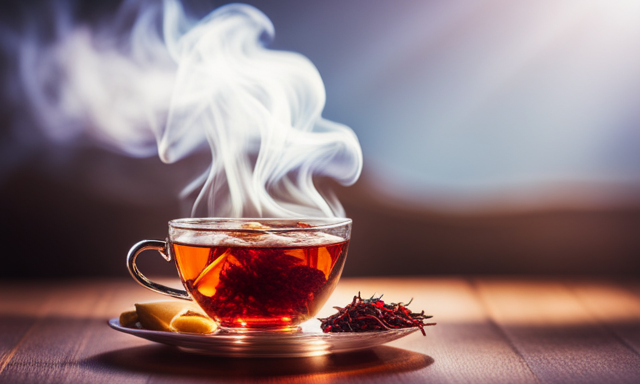
Similar to a cozy hug on a cool day, rooibos tea has become my favorite drink for its delightful flavor and many health advantages. From enhancing the immune system to supporting heart health, this incredible herbal tea has a wide range of benefits to provide.
As I delved into the research, I discovered that rooibos tea is rich in antioxidants, which help protect the body against harmful free radicals. It also supports digestive health, relieves stress, and promotes relaxation. Furthermore, this remarkable tea has been found to have anti-inflammatory properties, making it an excellent choice for those looking to reduce inflammation in their bodies.
As someone who values evidence-based research, I was thrilled to learn that rooibos tea may even aid in blood sugar regulation and support healthy skin. So, if you’re looking for a beverage that not only satisfies your taste buds but also provides an array of health benefits, rooibos tea is definitely worth considering.
Key Takeaways
- Rooibos tea reduces allergy symptoms and improves breathing by containing antioxidants like aspalathin and quercetin, reducing inflammation and histamine release, and alleviating hay fever symptoms like itchy eyes and congestion.
- Rooibos tea aids in blood sugar regulation by improving insulin sensitivity and glucose absorption, reducing insulin resistance in cells, and having a low glycemic index with minimal impact on blood sugar levels, which benefits overall blood sugar control and diabetes management.
- Rooibos tea provides natural remedies and alternative treatments by offering relief from allergies and decreasing symptoms, containing high levels of antioxidants, reducing inflammation and histamine release, and alleviating hay fever symptoms like itchy eyes, runny nose, and congestion.
- Rooibos tea improves overall health and well-being by enhancing health and reducing allergies, reducing inflammation and histamine release, alleviating hay fever symptoms like itchy eyes, runny nose, and congestion, benefiting blood sugar control and management, and reducing chronic inflammation associated with diabetes and blood sugar imbalances.
Rich in Antioxidants
Rooibos tea is packed with antioxidants, helping to protect your body from harmful free radicals. Antioxidants are compounds that neutralize these free radicals, preventing them from causing damage to cells and DNA.
Rooibos tea contains a variety of antioxidants, including aspalathin and quercetin, which’ve been shown to have potent antioxidant properties. These antioxidants help to reduce oxidative stress in the body, which’s a major contributor to aging and chronic diseases.
Not only do the antioxidant properties of rooibos tea help to combat aging, but they also’ve a positive impact on heart health. Research has shown that regular consumption of rooibos tea can help to lower blood pressure and improve cholesterol levels, reducing the risk of heart disease. The flavonoids found in rooibos tea have been found to have anti-inflammatory effects, further promoting heart health.
In conclusion, drinking rooibos tea can provide you with a multitude of health benefits. From its antioxidant properties and anti-aging effects to its ability to promote heart health, incorporating this delicious tea into your daily routine can be a simple and effective way to support your overall well-being.
Promotes Heart Health
Drinking this herbal infusion regularly can aid in maintaining a healthy heart, as studies have shown that it can help lower blood pressure by up to 7%. Rooibos tea is heart-friendly due to its rich antioxidant content, which helps protect the heart from oxidative stress and inflammation. These antioxidants, such as aspalathin and quercetin, have been found to improve cardiovascular health by reducing the risk of heart disease and improving blood circulation.
In addition, rooibos tea has been shown to have a positive effect on cholesterol levels. Studies indicate that it can help lower LDL cholesterol while raising HDL cholesterol levels. This combination of heart-friendly properties makes rooibos tea a great choice for promoting heart health and reaping its cardiovascular benefits.
Moving on to the next topic, rooibos tea also supports digestive health…
Supports Digestive Health
To improve and maintain your digestive health, incorporating rooibos tea into your daily routine can work wonders. This herbal infusion has been found to have several benefits for the digestive system.
Here are three ways rooibos tea supports digestive health:
-
Promotes a healthy gut flora: Rooibos tea contains antioxidants that help maintain a balanced gut microbiome. A healthy gut flora is essential for proper digestion and nutrient absorption.
-
Provides indigestion relief: Rooibos tea has been shown to have anti-inflammatory properties, which can help reduce symptoms of indigestion such as bloating, gas, and stomach cramps.
-
Soothes the digestive tract: The anti-spasmodic properties of rooibos tea can provide relief from digestive discomfort by calming the muscles in the digestive tract.
In addition to supporting digestive health, rooibos tea also helps reduce inflammation, which we’ll explore in the next section.
Helps Reduce Inflammation
If you’re looking to soothe inflammation and experience a sense of calm, incorporating this herbal infusion into your routine might just be the cherry on top. Rooibos tea has been shown to have anti-inflammatory properties, making it a natural remedy for reducing pain and inflammation.
Research suggests that the antioxidants present in rooibos tea can help to reduce the production of pro-inflammatory molecules in the body, thus alleviating symptoms associated with inflammation. Additionally, rooibos tea contains several compounds, such as aspalathin and nothofagin, which have been found to have anti-inflammatory effects.
By incorporating rooibos tea into your daily routine, you may experience a reduction in inflammation and a greater sense of well-being. This soothing herbal infusion also boosts the immune system, helping to keep you healthy and vibrant.
Boosts the Immune System
Supercharge your immune system with the incredible power of this herbal infusion. Rooibos tea has been found to boost the immune system, helping to ward off illness and keep you feeling healthy.
This natural beverage is packed with antioxidants that help to strengthen the immune system and protect against free radicals. In addition to boosting immunity, rooibos tea also provides a natural energy boost, making it a great alternative to caffeine-filled drinks. It’s been shown to improve cognitive function and enhance mental clarity, helping you stay focused and alert throughout the day.
So, if you’re looking for a delicious and effective way to support your immune system and boost energy, look no further than rooibos tea. Plus, it aids in weight management by promoting a healthy metabolism.
Aids in Weight Management
Moving on from the previous subtopic on how rooibos tea boosts the immune system, let’s now explore its benefits for weight management. If you’re looking to shed a few pounds or simply maintain a healthy weight, rooibos tea can be a valuable addition to your routine.
Studies have shown that this herbal tea can help with weight loss by increasing metabolism and aiding in fat breakdown. The antioxidants found in rooibos tea, such as aspalathin, have been found to reduce the formation of fat cells and improve lipid metabolism. Additionally, rooibos tea is naturally calorie-free and can be a great alternative to sugary beverages, making it a smart choice for weight-conscious individuals.
As we delve into the next section about how rooibos tea relieves stress and promotes relaxation, you’ll discover even more reasons to incorporate this wonderful tea into your daily routine.
Relieves Stress and Promotes Relaxation
One of the remarkable effects of indulging in a warm cup of rooibos tea is its ability to create a sense of calm and tranquility, helping you unwind after a long and hectic day. This soothing beverage promotes mental well-being by relieving stress and anxiety, allowing for a peaceful state of mind. Research suggests that the antioxidants found in rooibos tea can enhance sleep quality, making it an excellent choice for those struggling with insomnia or restless nights. To illustrate the benefits of rooibos tea in relieving stress and promoting relaxation, take a look at the table below:
| Rooibos Tea Benefits |
|---|
| Promotes mental well-being |
| Enhances sleep quality |
In addition to these benefits, rooibos tea also supports healthy skin.
Supports Healthy Skin
When it comes to promoting healthy skin, rooibos tea has a remarkable impact. This antioxidant-rich beverage has been found to promote skin rejuvenation and enhance skin elasticity. Here are four ways in which rooibos tea benefits your skin:
- Reduces the appearance of wrinkles and fine lines.
- Fights against free radicals that damage skin cells.
- Soothes and calms irritated skin, reducing redness and inflammation.
- Improves overall skin tone and texture.
Research has shown that the antioxidants in rooibos tea can help protect the skin from environmental stressors and promote a more youthful complexion. By incorporating rooibos tea into your daily routine, you can enjoy the benefits of healthier, more radiant skin.
And as we move on to the next section, you’ll discover how rooibos tea can also help manage allergies.
Helps to Manage Allergies
By incorporating rooibos tea into your daily routine, you can find relief from allergies and experience a significant decrease in symptoms, making your days filled with more clear breathing and fewer sneezes. Rooibos tea is known for its natural remedies and alternative treatments, particularly for allergies. This herbal tea contains high levels of antioxidants, such as aspalathin and quercetin, which have been shown to reduce inflammation and histamine release in the body.
Studies have also indicated that rooibos tea can help to alleviate symptoms of hay fever, such as itchy eyes, runny nose, and congestion. Additionally, the anti-inflammatory properties of rooibos tea may aid in blood sugar regulation. This makes it an excellent choice for those looking to manage their allergies and improve their overall health.
Now, let’s explore how rooibos tea may aid in blood sugar regulation.
May Aid in Blood Sugar Regulation
Boost your health and keep your blood sugar levels stable with the potential of rooibos tea to aid in blood sugar regulation. Here are four reasons why rooibos tea may be beneficial for blood sugar control and diabetes management:
-
Anti-diabetic properties: Rooibos tea contains aspalathin, a unique antioxidant that’s been shown to improve insulin sensitivity and glucose absorption, helping to regulate blood sugar levels.
-
Reduces insulin resistance: Studies have found that rooibos tea may decrease insulin resistance in cells, allowing for better utilization of glucose and improved blood sugar control.
-
Low glycemic index: Rooibos tea has a low glycemic index, meaning it has a minimal impact on blood sugar levels. This makes it an ideal beverage for individuals looking to manage their blood sugar levels.
-
Anti-inflammatory effects: Chronic inflammation is often associated with diabetes and blood sugar imbalances. Rooibos tea’s anti-inflammatory properties may help reduce inflammation and support overall blood sugar regulation.
Incorporating rooibos tea into your daily routine may offer potential benefits for blood sugar control and diabetes management.
Frequently Asked Questions
Can rooibos tea help with managing allergies?
Yes, rooibos tea can help with managing allergies. It supports the immune system and has anti-inflammatory properties, which can alleviate symptoms of allergies. Additionally, it promotes respiratory health and soothes the respiratory system.
Is rooibos tea effective in managing blood sugar levels?
Rooibos tea, a natural alternative diabetes treatment, has shown potential in regulating blood sugar levels. Research suggests that it may help enhance insulin production and improve insulin sensitivity, making it a promising option for managing blood sugar.
Does rooibos tea have any benefits for skin health?
Rooibos tea has numerous benefits for skincare. It contains antioxidants that help protect the skin from damage and promote collagen production, resulting in healthier, younger-looking skin. Additionally, its anti-inflammatory properties can soothe skin conditions like acne and eczema.
Can rooibos tea help in reducing stress and promoting relaxation?
Rooibos tea is like a soothing blanket for the mind, helping me manage stress and find relaxation. Studies show its calming properties promote a sense of calm and tranquility, making it a great choice for stress management and relaxation techniques.
Is rooibos tea beneficial for weight management?
Rooibos tea can support weight management by improving digestion and boosting metabolism. Studies suggest its antioxidant properties aid in fat oxidation and can help reduce obesity-related inflammation.
Conclusion
In conclusion, sipping on a cup of rooibos tea is like embracing a warm hug from Mother Nature herself. It’s antioxidant-rich properties protect our bodies from the harmful effects of free radicals, while it promotes heart health and supports digestion, keeping us thriving. By reducing inflammation, boosting our immune system, and relieving stress, rooibos tea acts as a tranquil oasis in our hectic lives. It even helps us put our best face forward with its support for healthy skin. With rooibos tea in our hands, we can manage allergies and regulate blood sugar levels with ease.
So, let’s raise our mugs and toast to the remarkable benefits of this remarkable tea. Cheers to a healthier, happier life!
-

 Tea Brewing and Preparation6 days ago
Tea Brewing and Preparation6 days agoThe Ultimate Guide To Authentic Yogi Tea: A Spiced Immune-Boosting Ayurvedic Delight
-
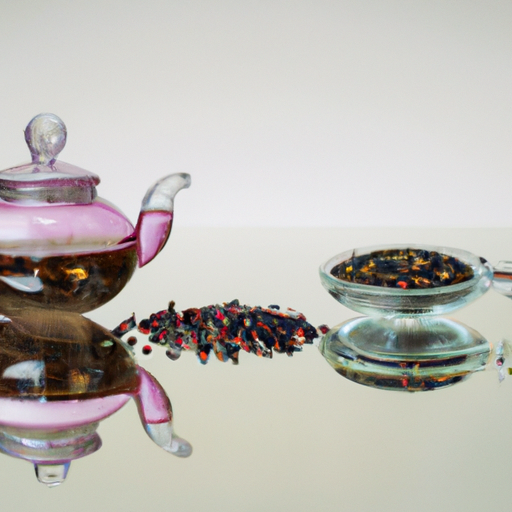
 Herbal Tea1 day ago
Herbal Tea1 day agoHow To Add Peppercorns To Herbal Tea Blends
-

 Turmeric Tea6 days ago
Turmeric Tea6 days agoIs Turmeric Good For Tooth Inflammation
-
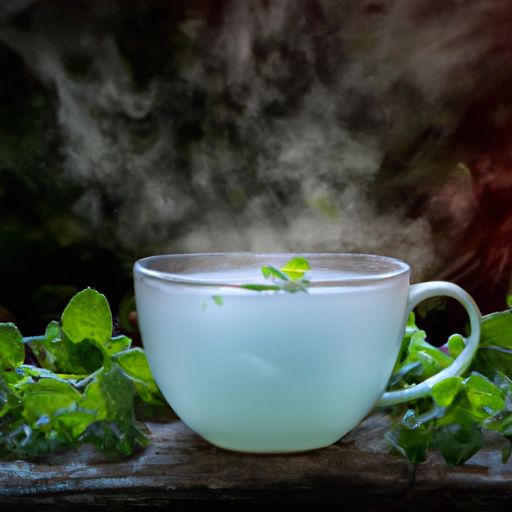
 Herbal Tea2 days ago
Herbal Tea2 days agoHow Does Peppermint Herbal Tea Help Clear Up A Cold
-

 Turmeric Tea6 days ago
Turmeric Tea6 days agoIs Turmeric Tea Good Before Bed
-

 Herbal Tea6 days ago
Herbal Tea6 days agoWhat Herbal Tea Is Good For Diverticulitis
-
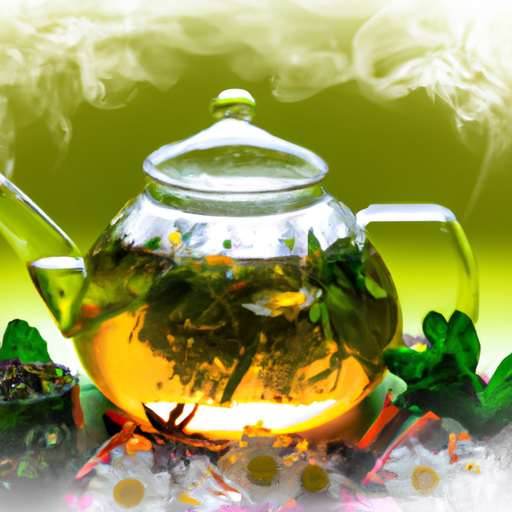
 Herbal Tea5 days ago
Herbal Tea5 days agoHow Much Potassium Is In Herbal Tea
-

 Herbal Tea2 days ago
Herbal Tea2 days agoHow Much Caffeine Does Berry Berry Herbal Tea Have In Iced Form










